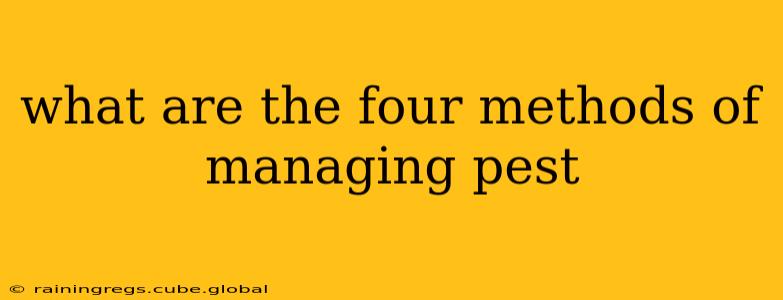The Four Main Methods of Pest Management: A Comprehensive Guide
Pest management is crucial in various sectors, from agriculture and horticulture to public health and home maintenance. Effective pest control relies on a multifaceted approach, minimizing negative environmental impacts while achieving effective pest suppression. Instead of relying on a single method, integrated pest management (IPM) utilizes a combination of strategies. Let's explore the four primary methods:
1. Cultural Control: Prevention Through Environmental Modification
Cultural control focuses on manipulating the environment to make it less hospitable to pests. This proactive approach prevents pest infestations before they even begin, reducing the need for more aggressive interventions. Examples include:
- Crop Rotation: Alternating crops disrupts the life cycle of many pests that thrive on specific plants. This prevents pest populations from building up in the soil or on plants.
- Sanitation: Removing weeds, debris, and other potential pest habitats eliminates breeding grounds and reduces food sources. Proper sanitation is particularly crucial around buildings and in gardens.
- Resistant Varieties: Planting pest-resistant crops can significantly reduce the impact of infestations. These plants have inherent characteristics that make them less susceptible to pest damage.
- Proper Planting and Spacing: Ensuring adequate spacing between plants promotes better airflow and sunlight penetration, discouraging pest development and fungal growth, which can attract pests.
- Water Management: Proper irrigation techniques can reduce the attractiveness of certain habitats for specific pests. Overwatering can create ideal breeding conditions for some insects, while underwatering can stress plants and make them more susceptible.
2. Biological Control: Nature's Solution to Pest Problems
Biological control leverages natural enemies of pests to reduce their populations. This eco-friendly approach often involves introducing beneficial organisms, like predators, parasites, or pathogens, to control pest numbers. Examples include:
- Predatory Insects: Ladybugs, lacewings, and praying mantises are examples of beneficial insects that prey on many common garden pests like aphids and mealybugs.
- Parasitic Insects: Certain wasps and flies lay their eggs in or on pests, eventually killing them. These natural parasites are highly effective in controlling specific pest species.
- Pathogens: Bacteria, fungi, and viruses that specifically target pest species can be used as biopesticides. These are often more specific than chemical pesticides and pose less risk to non-target organisms.
- Introducing Natural Predators: This method involves deliberately introducing predators or parasites into an environment to control a particular pest. This requires careful research and planning to ensure the introduced species doesn't become an invasive problem itself.
3. Mechanical Control: Physical Removal and Barriers
Mechanical control involves physically removing pests or creating barriers to prevent them from reaching target areas. This hands-on approach is often used in conjunction with other methods. Examples include:
- Trapping: Various traps, including sticky traps, pheromone traps, and light traps, can effectively catch and remove pests from an area.
- Handpicking: Manually removing pests from plants is an effective method for small-scale infestations.
- Physical Barriers: Screens, nets, and other physical barriers can prevent pests from accessing plants or buildings.
- Vacuuming: Vacuuming can be useful for removing pests from carpets, furniture, and other surfaces.
4. Chemical Control: Targeted Pesticide Application
Chemical control employs pesticides to kill or repel pests. While effective, it should be considered a last resort due to potential environmental and health risks. Responsible use necessitates following label instructions carefully and employing Integrated Pest Management (IPM) principles. This means selecting the least toxic pesticide possible and using it only when necessary. Examples include:
- Insecticides: Chemicals that kill insects.
- Herbicides: Chemicals that kill weeds.
- Fungicides: Chemicals that kill fungi.
- Rodenticide: Chemicals that kill rodents.
Important Note: Integrated Pest Management (IPM) is the most sustainable and effective approach. It involves combining several of these methods to achieve long-term pest control while minimizing negative environmental and health impacts. Careful monitoring, identification, and a strategic approach are key to successful IPM.
Frequently Asked Questions (Addressing Potential "People Also Ask" queries)
What are the disadvantages of chemical pest control? Chemical pesticides can harm beneficial insects, pollute water sources, and pose risks to human health. They can also lead to pesticide resistance in pests, making them less effective over time.
How can I choose the right pest control method? The best method depends on the specific pest, the environment, and your tolerance for risk. IPM emphasizes a proactive, multi-pronged approach that prioritizes prevention and less toxic methods before resorting to chemical control.
Is biological control always effective? Biological control can be highly effective, but its success depends on factors like the availability of suitable natural enemies and environmental conditions. It often requires patience and careful monitoring.
What is the most environmentally friendly pest control method? Cultural and biological controls are generally considered the most environmentally friendly, as they minimize the use of synthetic chemicals and rely on natural processes.
This comprehensive guide provides a strong foundation for understanding the four primary methods of pest management. Remember that responsible and informed choices are critical for effective and sustainable pest control.
